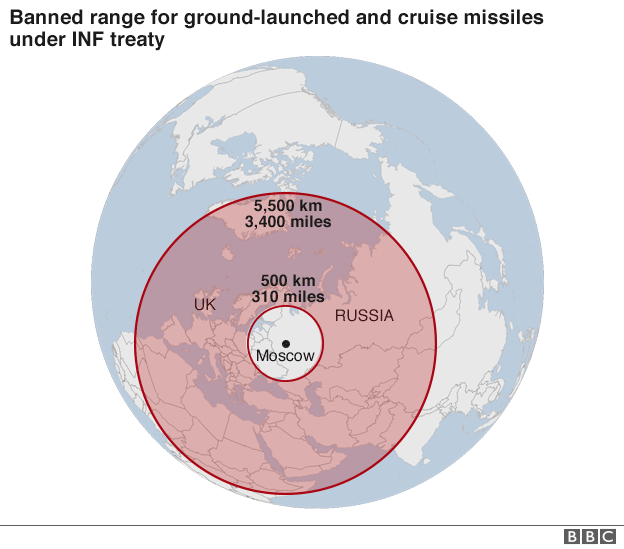The world is yet again shocked by the US decision to withdraw from the 1987 Intermediate Nuclear Forces (INF) Treaty. President Donald Trump demanded that “Unless Russia comes to us and China comes to us and they all come to us and they say, ‘Let’s all of us get smart and let’s none of us develop those weapons,’ but if Russia’s doing it and if China’s doing it and we’re adhering to the agreement, that’s unacceptable.”
The INF Treaty is an agreement to eliminate the development, production, and deployment of nuclear and conventional ballistic and ground-launched cruise missiles with a range greater than 500 kilometers and less than 5,500 kilometers. In early 1977, the Soviets started replacing aging Soviet systems with intermediate-range missiles, such as the SS-20 Saber, capable of threatening Western Europe from well within the Soviet territory. The SS-20 was regarded as a highly effective offensive nuclear weapon that threatened all of Western Europe.
The Western foreign and defense ministers were concerned that the Warsaw Pact had gained a significant advantage in the nuclear systems that directly threatened Western Europe. In response to the mounting pressure, NATO deployed the Pershing II ballistic missile in West Germany and the Ground-Launched Cruise Missile (GLCM) in Belgium, Italy, the Netherlands, and the United Kingdoms. Although the Tit-for-Tat resulted in anti-nuclear marches, demonstrations, and sit-ins at US bases across Western Europe, it also forced the Soviet Union to open negotiations and preliminary discussions, which ended up in the signing of the INF Treaty on 8 December 1987 by President Ronald Reagan and Soviet leader Mikhail Gorbachev.
Since the signing of the treaty, both parties have often been accused of violations. The US accused Russia of violating treaty terms by testing the Novator 9M729, known to NATO as the SSC-8, cruise missile in 2008. The accusation was brought up again in 2014 and 2017.
Russia argues that the American decision to establish the Vertical Launching System (VLS) at the land-based “Aegis Ashore” missile defense sites in Poland and Romania is a violation of the treaty. The VLS can be used to fire both defensive (surface to air) and offensive (surface to surface) missiles by carrying out an update of software, loading different missiles, and different targeting data. Russia also states that Washington’s prevalent usage of armed UAVs such as the MQ-9 Reaper also violates the INF Treaty.

John Bolton, Trump’s third national security adviser, is the main driver of the proposal to end the INF treaty. Former US officials say Bolton is also blocking talks on extending the 2010 New Start treaty with Russia limiting deployed strategic nuclear warheads and their delivery systems. It seems like Bolton is playing an increasingly overbearing role in the Trump Administration.
Trump has been hunkered down by the possibility of impeachment, and a loss in the House majority weighs heavily on his 2020 re-election bid. Since Trump’s inauguration in 2016, White House has been mired with senior staff exodus, and the besieged Trump surrounded himself with hawks. The appointment of Mike Pompeo as Secretary of State puts an uber-hawk in charge of foreign policy that is antagonistic towards Iran, North Korea, Russia and, lately, China. Bolton hired Tim Morrison as the senior director for countering weapons of mass destruction on the National Security Council, and together they are hostile to negotiated restrictions on U.S. nuclear weapons.
One thing’s for sure; the threat does not affect China too much. China has never signed the INF treaty, and therefore the pressure is not on China to react to Trump’s threat. Since the INF treaty does not ban sea-based Tomahawk Land-Attack Missile (TLAM), which can be launched from both surface ships and submarines, and the AGM-86 Air-Launched Cruise Missile (ALCM), China is “used to” these threats from the East and South Seas. Moreover, US does not have easy access to land around China and deploying in countries such as Japan, the Philippines or India, would require more complicated negotiations. Even the installation of the Terminal High Altitude Area Defense (THAAD) system caused major protests from the South Koreans. “I don’t see U.S. allies in Asia rushing to host U.S. road-mobile INF-range weapons,” said Kingston Reif, director of disarmament and threat-reduction policy at the Arms Control Association.
However, the collapse of the INF treaty would mean new missiles on the European Continent. Putin warned that the dismantling of the INF Treaty would certainly result in an arms race. The missiles that will reappear again in Western European countries, Russia “will have to respond in kind, and the European countries that agree to this – if things come to this – should understand that they will be subjecting their own territory to the threat of a possible retaliatory strike.” Western Europe is certainly not prepared for a new arms race, and with a hawkish Trump Administration that is not interested in keeping the INF Treaty, it should envision a Europe walking out of the shadow of the Marshall Plan.
Header Image: Photo: Emrah Yorulmaz, Reuters
The views and opinions expressed in this article are those of the author and do not necessarily reflect the official policy or position of The Geopolitics.

Joseph graduated with a degree in Business Administration from the National University of Singapore and is a CFA and CAIA charterholder. He enjoys geopolitics and study international politics extensively. Joseph currently lives in Hong Kong.

